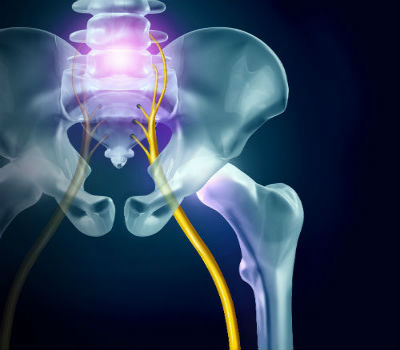The sciatic nerve begins at the pelvis and extends through the buttocks and glutes, all the way down each leg. Sciatic nerve pain develops in individuals with unusual amounts of pressure build-up on the sciatic nerve and can be treated with the help of a chiropractor.

The following tips should help you relieve sciatic nerve pain from home:
1. Stretching
The most efficient way to eliminate pain is to try various sciatica stretches that rotate the hips. This external hip rotation provides pain relief to the sciatic nerve by gently exercising it.
Here are a few stretches to try at home:
- Reclining Pigeon Pose
This stretch is a common yoga pose that aims to open the hip flexors and consequently, works well for sciatica pain relief.
First, lie on your back and pull the right leg towards you so that the knee makes a 90º angle. Pull your left leg directly in towards the chest and let the right ankle rest against the left knee. Holding this position for a few seconds, you should feel a stretch in the piriformis muscle, located in the buttocks behind the gluteus maximus.
There are multiple versions of the pigeon pose. Once you are comfortable with the reclining pigeon, move onto sitting and forward versions, if you feel ready to do so.
- Sitting Pigeon Pose
The sitting pigeon pose requires you to sit flat on the floor with your legs extended out straight in front of you. Bend the right leg and lift it over the left leg, making contact with your right ankle and left knee again. Lean your head forward and hold, you should feel the stretch throughout your lower back muscles and buttocks.
Now, if you feel comfortable with sitting pigeon, try forward.
- Forward Pigeon Pose
Finally, forward pigeon pose requires you to be close to the ground, on all fours, in a plank position with your arms fully extended.
Make sure your palms and legs are in line and pick up the right leg and bring it into your chest, moving it forward on the ground in front of the body. Your left leg is still fully extended, and the right ankle should be in line with the left thigh.
You will feel the stretch when you lean your upper body into the right leg while supporting your weight with your arms and upper body.
- Knee to Opposite Shoulder
The knee to opposite shoulder stretch works for sciatica treatment by stretching the piriformis muscles and gluteal muscles, which if inflamed, can cause sciatic pain and other symptoms.
This stretch requires you to lay on your back with the legs extended in front of you, and your feet flexed facing the ceiling. First, bend your right leg and wrap both hands around the knee. Pull this leg across the body until it meets the left shoulder and hold this position for 20 to 30 seconds.
This stretch should feel comfortable, so don’t push your body further than it can comfortably go.
- Sitting Spinal Stretch
The sitting spinal stretch aims to treat the compression of the vertebrae in the spine through opening up the spine to relieve pressure build-up around the sciatic nerve.
First, you should sit on the floor with your legs out in front of you and bend your right knee. Pick up the right leg and move your foot so that its flat on the ground to the left of the left knee.
Put the left elbow on the outside of the right knee to turn your body to the right. Hold this for about 20 seconds and complete on the other side.

2. Massage Therapy
Massaging on and around the affected area works just as well as over-the-counter pain relief medication for sciatica pain relief. Chiropractors can perform deep tissue massage to eliminate pressure around the sciatic nerve, as massaging soothes the tension built up in the muscles.
3. Good Posture
Focusing on improving your posture regularly can, in the long-term, improve your experience with sciatica, and eliminate most of your pain. Most people with sciatic nerve pain do not realize that improper posture is largely responsible for their issues. Improper posture compromises the strength of the lower back muscles, making them weaker and more susceptible to sciatica.
4. Gentle Exercise
Aside from yoga stretches, other forms of gentle non-contact exercise can be helpful in the elimination of sciatic nerve pain. Lower back pain exercises are designed to re-strengthen the weakened lower back muscles and restore hip flexibility.







